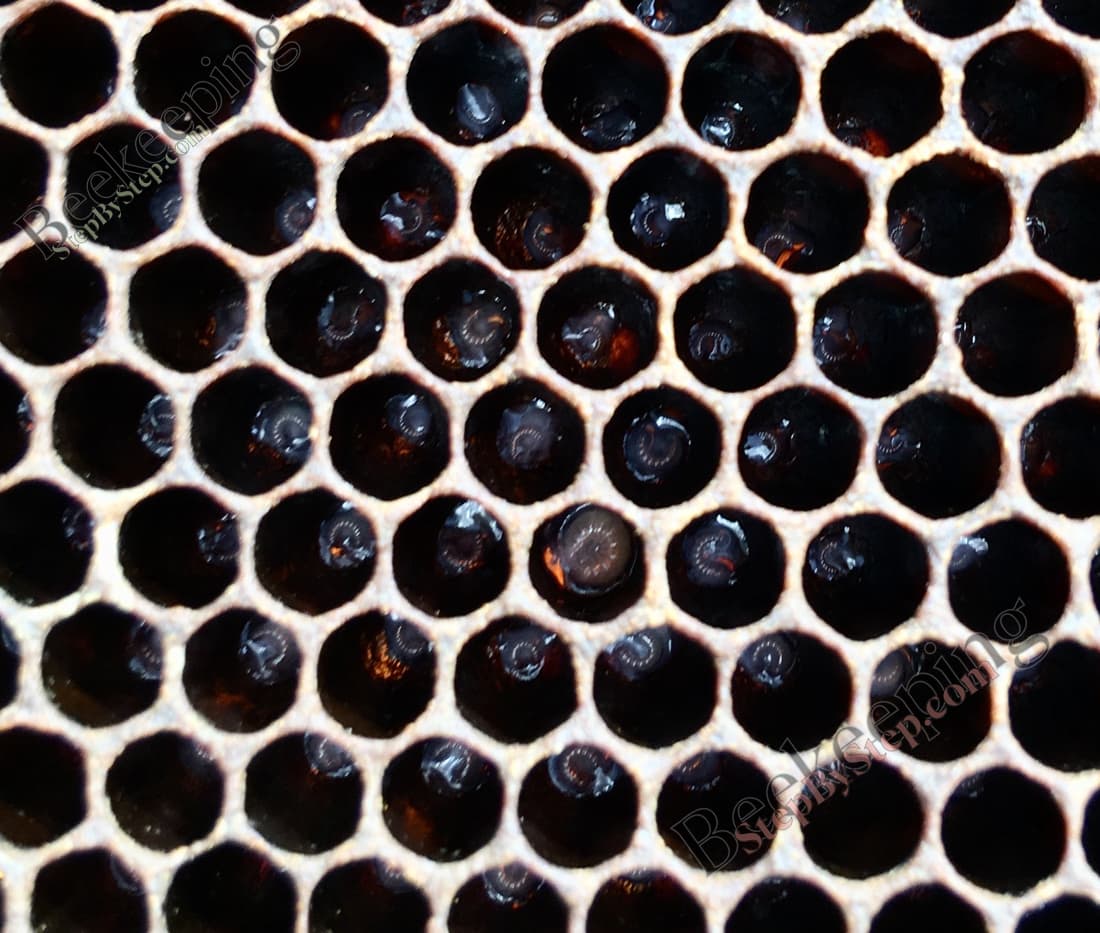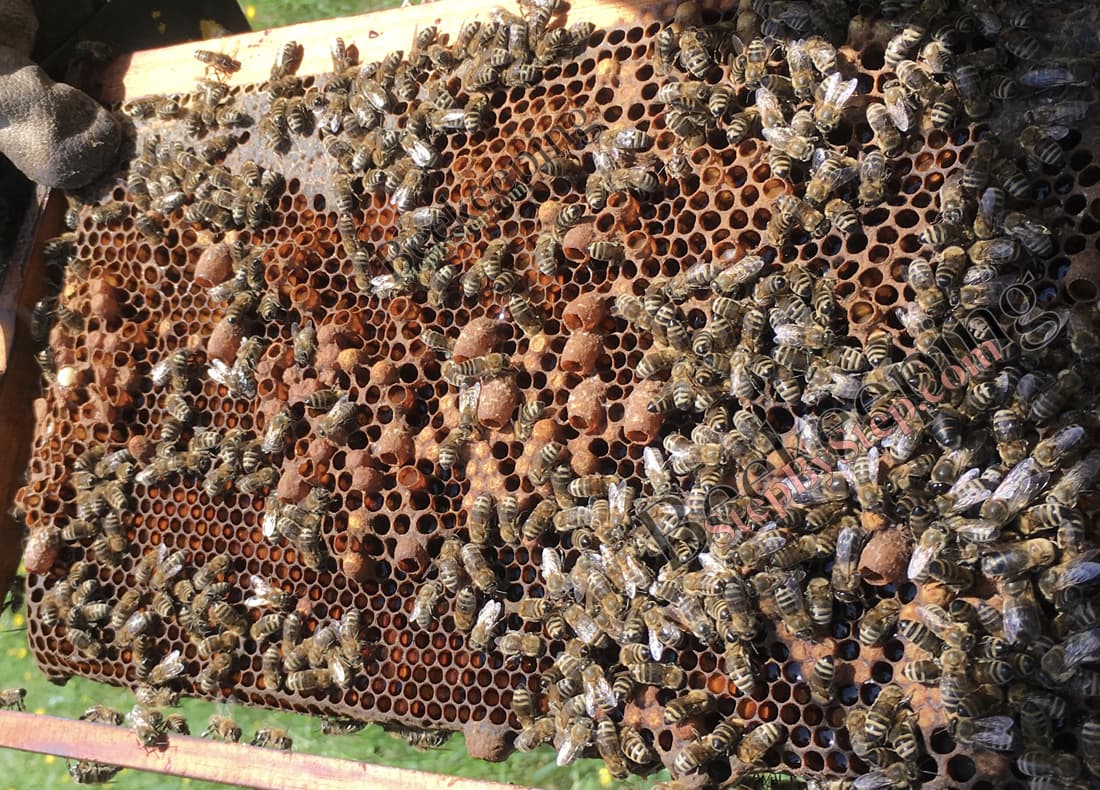Here we need to consider two possibilities:
![]() The colony lost its queen bee and started making queen cells, and
The colony lost its queen bee and started making queen cells, and
![]() The colony lost its queen but isn't capable of making a new queen.
The colony lost its queen but isn't capable of making a new queen.
First situation - emergency queen cells
This happens if the colony suddenly lost their queen. All the time until that moment their queen was laying eggs. So the colony has appropriate young larvae and is capable of making itself a new queen.
At the moment queen disappeared from the hive, there was eggs and young larvae (up to 3 days old) inside the hive.
Advertisement :

Beekeeping for Beginners
Everything you need to know!
This is a full beekeeping course for beginners.
This situation may happen if:
![]() The beekeeper accidentally squished the queen while inspecting
The beekeeper accidentally squished the queen while inspecting
![]() Some pest got inside the hive and killed or injured the queen (hornet, wasp, a mouse in the winter etc.)
Some pest got inside the hive and killed or injured the queen (hornet, wasp, a mouse in the winter etc.)
![]() If the queen is injured, not suitable for some reason or too agitated, the bees may have killed her themselves. (Note that this is not the same as supersedure where the old queen is present until young queen starts laying).
If the queen is injured, not suitable for some reason or too agitated, the bees may have killed her themselves. (Note that this is not the same as supersedure where the old queen is present until young queen starts laying).
![]() In case of robbery, robber bees can kill the queen
In case of robbery, robber bees can kill the queen
![]() The queen dies due to unknown reasons etc.
The queen dies due to unknown reasons etc.

As soon as the bees notice that the queen is gone, they start making emergency queen cells in order to make a new queen as soon as possible.
Shortly, in about 2 or 3 days, a large amount of queen cells can be spotted inside the hive.
Detailed information on queen cells you can find here: Queen Cells.
Learn how to recognize emergency queen cells among other types here: Three Kinds Of Queen Cells.

In this case, the colony is capable of solving the problem on its own.
And although the new queen may not be that good (if the beekeeper doesn't do anything about it) the colony is not doomed.
How to recognize:
![]() Large number of emergency queen cells
Large number of emergency queen cells
![]() There are no eggs
There are no eggs
![]() The queen is nowhere to be found
The queen is nowhere to be found
Solution:
1Let the bees make their new queen by themselves - Let Bees Make Their Own Queen.
2Introduce new mated queen - New Queen Introduction.
3Combine with another good queenright bee colony - Combining Two Colonies.
Second situation - the colony isn't capable of making a new queen
This case occurs when lately there hasn't been any new eggs so the bees don't have eggs or young brood from which they can make a new queen.
This may happen:
![]() If the young queen emerged from emergency or swarm cell failed to return from her mating flight.
If the young queen emerged from emergency or swarm cell failed to return from her mating flight.
So this can happen after colony swarmed or lost its queen and had emergency queen cells but the new queen didn’t manage to come back after mating.
During the supersedure the old queen is still in the hive laying eggs so this problem doesn’t really exist, if the young queen doesn't come back from mating the bees will simply make a new queen cell.
![]() If the colony lost its queen during the winter or some other period during which she stopped laying (e.g. period with lack of food).
If the colony lost its queen during the winter or some other period during which she stopped laying (e.g. period with lack of food).
How to recognize:
![]() No eggs
No eggs
![]() No queen cells
No queen cells
![]() The queen is nowhere to be found
The queen is nowhere to be found
![]() The bees are agitated
The bees are agitated
![]() As soon as you open that beehive the bees start fanning. See - Queenless Colony Behavior - Fanning.
As soon as you open that beehive the bees start fanning. See - Queenless Colony Behavior - Fanning.
Before you decide what you are going to do, be absolutely sure that the bee colony is queenless. The colony that has any kind of queen, even a laying workers, will kill the added queen and destroy added queen cells.
Detailed steps on how to be sure that the hive is really queenless - No Eggs, No Queen Cells - Is It Queenless?.
Solution:
If you are sure that the beehive is queenless:
1Add a new queen bee - New Queen Introduction.
2Add a mature queen cell - Queen Cell Introduction.
3Combine with another good queenright colony - Combining Two Colonies.
Adding a frame of young brood for beehive to make new queen can be done but it also can be tricky (especially for the beginner beekeeper or if the beehive is not very strong) and may not be done in the early spring or fall.
If the honey bee colony is left without a queen, a laying workers will occur.
More details about laying workers: Laying Workers.